“Corp sucks.”
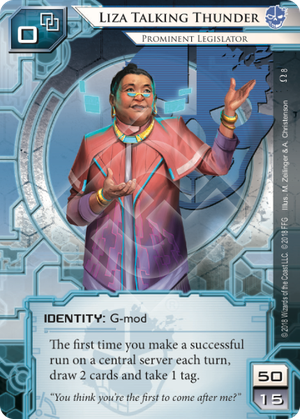
I’ve heard that a lot this year. If you’ve had a conversation about the Android: Netrunner and NISEI meta with someone, you’ve probably heard something similar at some point. Over the course of the past year or more, we’ve seen the rise (and sometimes fall) of powerful Corp decks. As the metagame has evolved, both through Most Wanted List updates and through tournaments, it has gradually grown increasingly polarized. Many matchups are strongly binary. The recent Liza Talking Thunder decks with Paparazzi and Dummy Box are the latest example of strategies that are challenging to defeat unless your deck is built in a specific way or slots very specific tech, but there have been others on both sides through the course of this year.
I want to explore the problems with the current metagame, how we got here, and what we can do about it.
How Did We Get Here?
To understand how we got to this point, we have to go back in time before the release of the Revised Core Set, when the power level of the game was peaking. With the original Core Set, Mumbad Cycle cards, Terminal Directive, and Flashpoint Cycle cards all in the pool, decks on both sides were capable of the highest tiers of degeneracy that Android: Netrunner and NISEI players have ever seen. These powerful, skill-testing decks were fun for some players, but I think that meta drove away many people who were looking for the “remotes and ice” game they started out playing.
Since then, the power level of the game has dropped considerably. The transition of the Most Wanted List to a banned and restricted list undid the worst sins of peak Mumbad, and many staple cards rotated out with the introduction of the Revised Core Set. I’m a believer in rotation and meta shakeups, and I think that meta defining power cards shouldn’t be evergreen the way Account Siphon and Parasite were. However, it’s hard to miss the near-direct, supposedly “fixed” replacements for some of those power cards — Diversion of Funds, Trypano / Chisel, and others. Those replacements are generally much lower power than the original card, which results in either a less satisfying version of the same basic play pattern (as with Diversion of Funds), or the “fixed” card being unplayable in competitive decks (Trypano, Chisel).

As the power level of the game has declined, players have continued to look for edges, inefficiencies, and whatever remaining degeneracy we can find. Individual power cards can now distort an entire meta, which we saw more recently with Crowdfunding in the NISEI MWL 3.2 environment. I like the design of Crowdfunding, but at 3 influence in a lower power environment, it solved core issues for a huge majority of Runner decks in three deck slots: setup economy (with zero barrier to entry, no less), early game acceleration via the card draw, and late game sustain since it can be recurred. It was also virtually immune to hate (“ignoring all costs”). The power of Crowdfunding in the MWL 3.2 environment pushed Corp players to find the most degenerate possible win conditions, which gave us the SIU and Zealous Judge combo Gagarin deck, Board Man, that tore up Regionals until it was dealt with.
Crowdfunding also highlights another aspect of the game that has changed over time: pace. Runners set up faster, and have more late game inevitability once their rigs are in place. Corps are therefore pushed to win earlier and earlier, or risk being locked down and having to painfully lose at whatever tempo agendas enter the game. In the MWL 3.2 environment, Board Man and Industrial Genomics both evaded this by going absurdly fast — Board Man would often kill Runners on roughly the fifth turn.
I typically describe the state of Corp to other players over the last year or so as “rush or die,” which is pretty much what you have to do as a Corp if you don’t have an “unfair” trick up your sleeve like Board Man or IG49.
What Corp is Missing
There is a large yellow elephant in this room who I haven’t mentioned yet, very much intentionally.
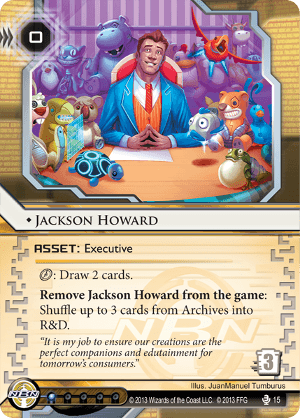
Jackson Howard has been discussed ad nauseam over the years of Android: Netrunner and NISEI. Initially viewed by many players as a patch to the game rules to address agenda flood, Jackson turned out to have much broader effects on the game. Fundamentally, what Jackson gives Corps is game flow control:
- Speed up the game by drawing for key pieces (including agendas) when you want them
- Slow the game down and recycle agendas when you aren’t set up, are broke, or are behind
Doing all of this in one card for one influence is extremely potent, but Corp fundamentally needs some ability to influence the flow of the game and respond to how quickly or slowly the Runner manages to get set up and apply pressure. And to be fair, at the time Jackson was printed, Corps had limited agenda suite choices and no ways to address the variance of having cards trashed out of R&D with no interaction by Runners playing Noise.
However, Jackson rotated near the power level peak. Since his rotation, Jackson’s effects have been distributed across multiple cards, which see play to varying degrees: Rashida Jaheem, Preemptive Action, Gatekeeper, Drudge Work, and Genotyping. Just at the surface level, replacing 3x Jackson in most Corp decks with 3x Rashida Jaheem is an excellent bellweather for how Jackson’s rotation has changed the game. Almost every Corp has to move faster and rush harder, or lose to Runner late game inevitability. If drawing quickly with Rashida in order to set up results in too many agendas entering the game before the Corp is ready to defend them, well, you can pitch some and hope they last a turn so you can Preemptive, pitch some and hope to turn that into a kill later, or you can lose. Usually, the last one is what happens.
Former Android: Netrunner lead designer Damon Stone once described Jackson Howard as a crutch. I agree that packing all of Jackson’s functionality into one card made starting Corp deckbuilding with 3x Jackson Howard + 3x Hedge Fund much too easy, but the pendulum has swung too far in the other direction. Corps need game flow control, so I think replacing Jackson with only card draw and agenda shuffling — mostly in separate cards — was a mistake.
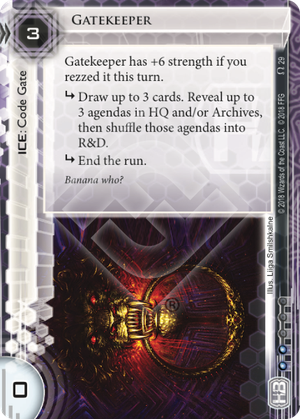
The main exception to this is Gatekeeper, which is exactly the sort of innovative design that is a perfect fit in a faction that has access to plenty of rush tools already and mostly needs a little agenda flood mitigation that (unlike Preemptive Action) has other useful effects. Drudge Work, in contrast, only stalls. Preemptive Action is typically useless when drawn early. Genotyping is almost exclusively a tool for damage decks, particularly IG49.
We don’t need to go all the way back to Jackson Howard being the answer for almost every Corp, but we need more Corp game flow control effects spread across the factions, preferably in fewer, higher-impact cards.
What Else Corp is Missing
Corp is also missing something else: win conditions. This has been mitigated somewhat with the introduction of the Uprising Booster Pack to the Worlds 2019 meta, which added useful and important cards on the Corp side. However, pre-Worlds, almost all of the best Corps relied on exactly one win condition: Hard-Hitting News. By “win condition,” I mean a powerful card that can turn the game in the Corp’s favour, if not win the game outright itself. You could instead say that High-Profile Target is the win condition and HHN is an enabler, but HHN decks can also run Psychographics or BOOM! to capitalize on a successful HHN. In this context, I’m talking about cards Corp players can build their decks around that offer paths to victory.
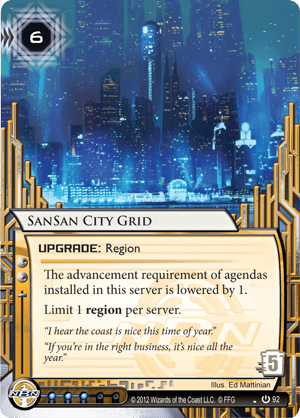
In past metas, Corps had tools that could enable wins without needing a significant economy lead over the runners. SanSan City Grid and Caprice Nisei are two examples. Cards along these lines now tend to be single-use, and therefore tempo-negative to use: Border Control, Audacity, Calibration Testing, Marcus Batty, Letheia Nisei, Ash 2X3ZB9CY, and so on. Essentially, Corps are expected to use these tempo-negative tools to get points, and then use rush tools like Rashida to recover the lost tempo. This can create sequencing problems, increasing draw order dependence and compounding the effects of the general lack of game flow control I described in the section on Jackson Howard.
It’s worth noting that the past examples of Corp power cards / win condition cards I mentioned — SanSan and Caprice — were both despised by a significant portion of the player base when they were in the game. However, I think this is a necessary consequence of printing Corp win condition cards that are powerful and flexible enough to be played in more than one competitive deck. SimonMoon covered this in considerable detail in his “Breaking News is Good for the Game” article from several years ago.
Most Corps now need an economic advantage as a baseline for winning, whether it’s via HHN trace, a taxing remote with Border Control(s) / Ash, an expensive board of assets like Jeeves Model Bioroids, or fast advance tools. Audacity is the main exception in the current meta, since while it’s single-use and tempo-negative, it costs zero credits. This is a far cry from the days of Fastrobiotics decks scoring AstroScript Pilot Programs from zero credits with a token and Shipment from SanSan. That’s an extreme example in the other direction, but it’s still a useful point of comparison. The need for an economic advantage turns many games into a draw-dependent economic battle: did the Corp draw too many agendas and not enough money early? They probably lose. Did the Runner not draw enough economy to contest a remote the Corp is using to rush agendas? They probably lose. This contributes to the polarization I mentioned in the first section, and in my view it isn’t a healthy state for the game overall.
What Can Be Done?
The basic outline of an ideal path forward looks like this: design or reprint flexible power cards, particularly on the Corp side, and particularly cards that enable game flow control without massively boosting rush strategies. The intention should be to raise the power level of non-rush Corp strategies in order to bring Corp up to the level of Runner, rather than using the MWL to bring Runner down so the game is balanced.
Of course, that’s much easier to say than it is to do. There aren’t enough flexible cards available in the MWL pool to simply unban a handful of power cards and solve the problems; the available power cards on the Corp side are all relatively narrow and only fit in a small number of decks. That means the burden falls on NISEI’s design and development teams to either create appropriate new cards, or reprint rotated cards that fit the bill. I don’t think Jackson Howard or Caprice Nisei should be directly reprinted at the moment, but SanSan City Grid is an excellent candidate for reintroduction to the meta. Even Estelle Moon, absurdly above curve as she is, may be worth a look as a flexible card that enables different styles of play. Such moves would need to be accompanied by some help for Runners as well, but there’s a card waiting in the wings that can be immediately freed if Corp diversity and power rises enough: Crowdfunding. It was too powerful in the MWL 3.2 environment, but future environments might support moving it to Restricted.
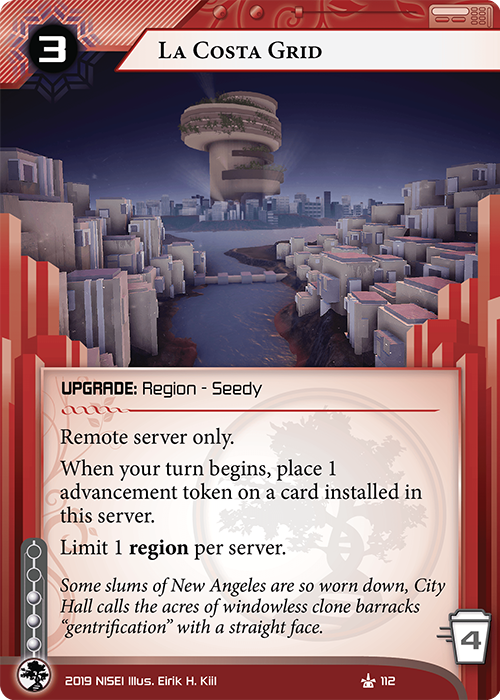
I do think NISEI recognize the problem, and not only because I talked to some NISEI members while I was working on this piece. The introduction of cards like La Costa Grid and Digital Rights Management are moving the Corp side of the meta in a better direction. On the other hand, while Cayambe Grid is powerful, it also operates along the economic axis. That makes it essentially an Ash with upside if you build your deck a certain way — that is, it’s a narrow card. It’s still a net positive and adds power to a popular but historically weak archetype, but it isn’t doing too much to diversify the broader meta. Overall, though, the Uprising Booster Pack cards did have the desired effect on the meta, even if the power imbalance and game flow problems I’ve outlined here still exist.
The future does hold promise. Hopefully, the remainder of Uprising will help further. Beyond that, the shift to System Gateway as an evergreen entry product will allow NISEI to use the annual System Cores to help define the Standard environment, introducing and removing power cards so that things change more frequently than set releases. Combined with an aggressive rotation schedule, System Cores will be able to cherry pick interesting, powerful, and / or beloved cards to return to the meta for a year at a time.
All of that, though, takes time and effort. The recent NISEI recruitment drive is a great reminder that this is now a community-led game, with everything done by volunteers. If we want to keep this game we all love alive and thriving, we need to help do the work ourselves. That means being active in the community, whether it’s sharing decklists, blogging, podcasting, streaming, playtesting, or even applying to join NISEI itself. Just thinking about the game and the meta, and saying what you think in a constructive way, is a contribution. Let’s keep doing what we can to help sustain this crazy game!
Acknowledgements
As I thought about the state of the game and the meta over the last ~6 months, I asked a lot of other people for their opinions and perspectives on the subject. Thanks in particular to these folks, who provided detailed and insightful thoughts:
anzekay, d1en, divadus, leburgan, miek, nemamiah, samrs, spags, webster, whiteblade
This obviously doesn’t imply that they agree with what I’ve written, but talking with them helped me reach the conclusions I have. Opinions are, as always, entirely my own.




